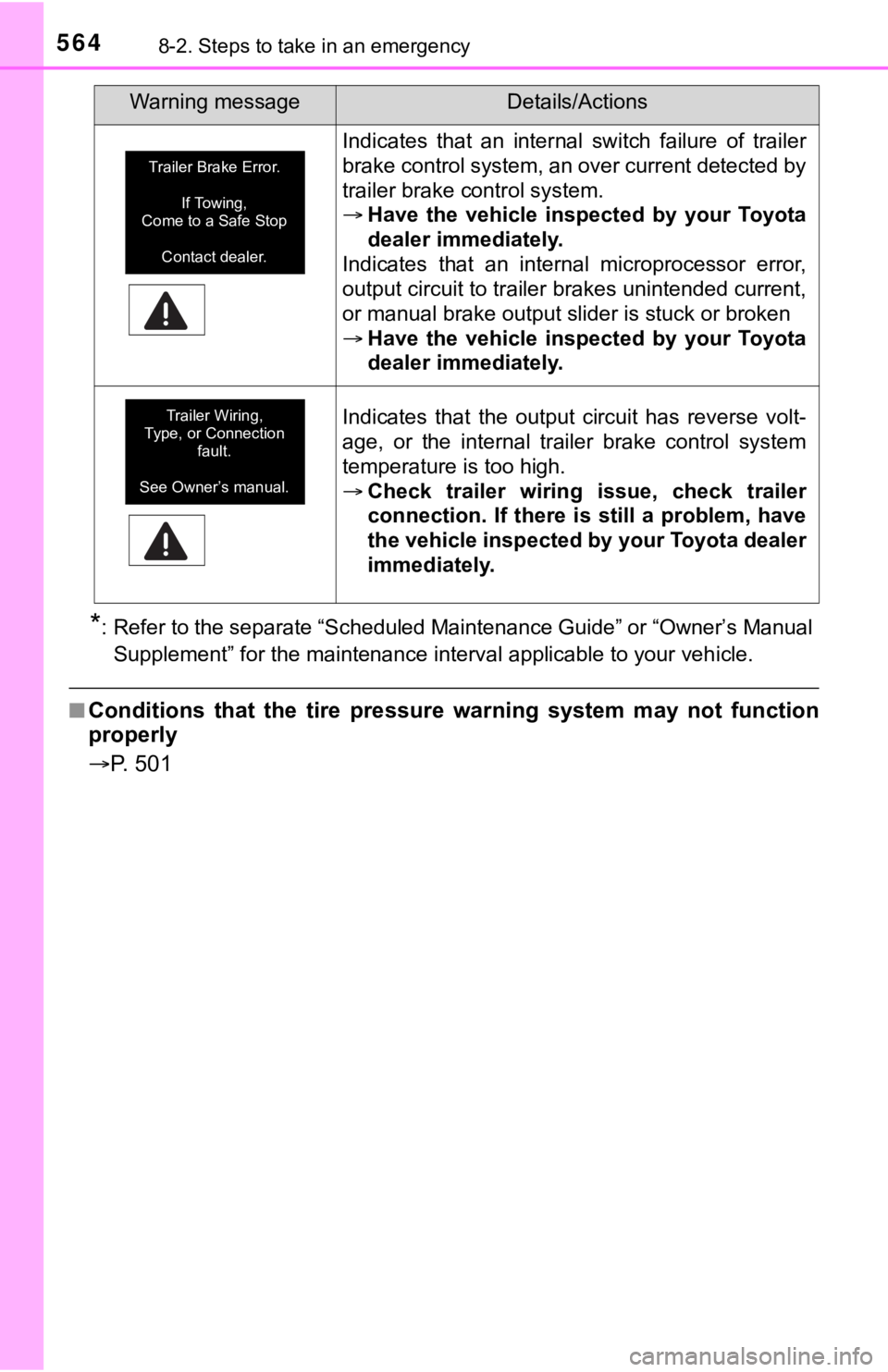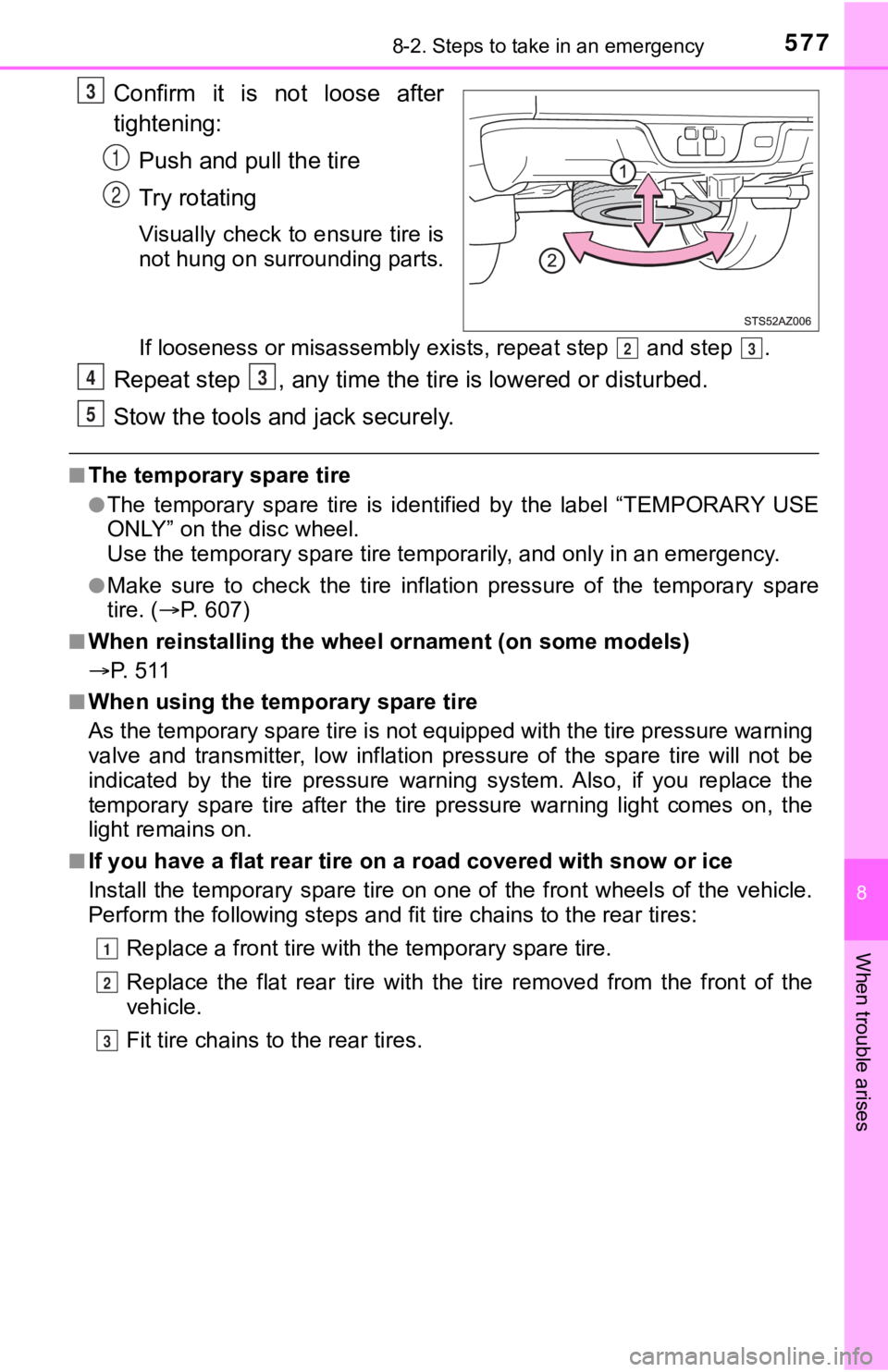Page 544 of 672
5448-2. Steps to take in an emergency
NOTICE
■To prevent damage to the vehicle when towing using a wheel-lift type
truck
● Do not tow the vehicle from the rear when the engine switch is in the
“LOCK” position or the key is removed.
The steering lock mechanism is not strong enough to hold the front wheels
straight.
● When raising the vehicle, ensure adequate ground clearance for towing at
the opposite end of the raised vehicle. Without adequate clearance, the
vehicle could be damaged while being towed.
■ To prevent damage to the vehicle when towing with a sling-type truck
Do not tow with a sling-type truck, either from the front or re ar.
■ To prevent damage to the vehic le during emergency towing
Do not secure cables or chains to the suspension components.
Page 563 of 672

5638-2. Steps to take in an emergency
8
When trouble arises
(If equipped)
Indicates that, since the VSC (Vehicle Stability
Control) system was turned off, the pre-collision
brake system operation is stopped.
Turn the VSC on. ( P. 304)
(If equipped)
Indicates that the pre-collision system is tempo-
rarily unavailable.
Please wait until the system returns. If the
message does not disappear, the system
may be malfunctioning. Have the vehicle
inspected by your Toyota dealer immedi-
ately.
(If equipped)
Indicates that the pre-collision system sensor is
dirty, covered with ice, etc.
Remove any dirt, ice, etc.
Indicates a malfunction in the RCTA (Rear Cross
Traffic Alert).
A buzzer also sounds.
Have the vehicle inspected by your Toyota
dealer.
Indicates that the VSC ECU or G sensor is not
communicating with trailer brake control system.
Indicates a malfunction in the VSC system.
Have the vehicle inspected by your Toyota
dealer immediately.
Warning messageDetails/Actions
VSC Turned Off
Pre-Collision Brake
System
Unavailable
Pre-Collision System Unavailable
Pre-Collision System Unavailable
Clean Sensor
Rear Cross Traffic Alert Malfunction
Visit Your Dealer
Trailer Brake Error. If Towing,
Come to a Safe Stop
with Manual Controls.
Contact dealer.
Page 564 of 672

5648-2. Steps to take in an emergency
*: Refer to the separate “Scheduled Maintenance Guide” or “Owner’s Manual
Supplement” for the maintenance interval applicable to your veh icle.
■Conditions that the tire pressure warning system may not functi on
properly
P. 5 0 1
Indicates that an internal switch failure of trailer
brake control system, an over current detected by
trailer brake control system.
Have the vehicle inspected by your Toyota
dealer immediately.
Indicates that an internal microprocessor error,
output circuit to trailer brakes unintended current,
or manual brake output slider is stuck or broken
Have the vehicle inspected by your Toyota
dealer immediately.
Indicates that the output circuit has reverse volt-
age, or the internal trailer brake control system
temperature is too high.
Check trailer wiring issue, check trailer
connection. If there is still a problem, have
the vehicle inspected by your Toyota dealer
immediately.
Warning messageDetails/Actions
Trailer Brake Error.
If Towing,
Come to a Safe Stop
Contact dealer.
Trailer Wiring,
Type, or Connection
fault.
See Owner’s manual.
Page 575 of 672
5758-2. Steps to take in an emergency
8
When trouble arises
Lower the vehicle.
Firmly tighten each nut two or
three times in the order shown
in the illustration.
Tightening torque:
154 ft·lbf (209 N·m, 21.3 kgf·m)
3
4
WARNING
■Stowing the flat tire
Failure to follow steps listed under stowing the tire may resul t in damage
to the spare tire carrier and loss of the tire, which could res ult in serious
injury or death.
Page 576 of 672
5768-2. Steps to take in an emergency
Vehicles with aluminum wheels: Remove the center wheel orna-
ment by pushing from the reverse side.
Lay down the tire with the valve
stem facing up and install the
holding bracket, inserting the
claw into the wheel lug nut hole.
Turn the jack handle extension
clockwise to take up slack in
the chain.
Then, check to ensure the claw is
in the wheel lug nut hole and the
holding bracket is centered in the
wheel hub.
Holding bracket
Claw
While raising, secure the tire, tak-
ing care that the tire goes straight
up without catching on any sur-
rounding part, to prevent it from
flying forward during a collision or
sudden braking.
Tightening torque:
34.7 ft·lbf (46.6 N·m, 4.8 kgf·m)
Stowing the flat tire, jack and all tools
1
incorrect
correct
O
1
2
Page 577 of 672

5778-2. Steps to take in an emergency
8
When trouble arises
Confirm it is not loose after
tightening:Push and pull the tire
Try rotating
Visually check to ensure tire is
not hung on surrounding parts.
If looseness or misassembly ex ists, repeat step and step .
Repeat step , any time the tire is lowered or disturbed.
Stow the tools and jack securely.
■The temporary spare tire
●The temporary spare tire is identified by the label “TEMPORARY USE
ONLY” on the disc wheel.
Use the temporary spare tire temp orarily, and only in an emergency.
●Make sure to check the tire inflation pressure of the temporary spare
tire. ( P. 6 0 7 )
■When reinstalling the wheel ornament (on some models)
P. 5 1 1
■When using the temporary spare tire
As the temporary spare tire is no t equipped with the tire pressure warning
valve and transmitter, low inflation pressure of the spare tire will not be
indicated by the tire pressure warning system. Also, if you rep lace the
temporary spare tire after the tire pressure warning light come s on, the
light remains on.
■If you have a flat rear tire on a road covered with snow or ice
Install the temporary spare tire on one of the front wheels of the vehicle.
Perform the following steps and f it tire chains to the rear tires:
Replace a front tire with the temporary spare tire.
Replace the flat rear tire with the tire removed from the front of the
vehicle.
Fit tire chains to the rear tires.
3
1
2
23
43
5
1
2
3
Page 589 of 672
5898-2. Steps to take in an emergency
8
When trouble arises
NOTICE
■To avoid damage to the trans mission and other components
● Avoid spinning the rear wheels and depressing the accelerator p edal more
than necessary.
● If the vehicle remains stuck even after these procedures are pe rformed,
the vehicle may require towing to be freed.
● When a warning message for the automatic transmission fluid tem perature
is displayed while attempting to free a stuck vehicle, immediat ely remove
your foot from the accelerator pedal and wait until the warning message
disappears. Otherwise, the transmission may become damaged.
( P. 555)
Page 595 of 672
5959-1. Specifications
9
Vehicle specifications
*1: The model code is indicated on the Certification Label. (P. 6 0 0 )
*2: Vehicles with towing package (hitch only)
*3: Vehicles with towing package
*4: Vehicles with towing package and large fuel tank
Model code*1EngineDriving
systemBed type
Vehicle capacity weight
(Occupants + lug- gage)
USK56L- CRTSKA
3UR-FE engine
4WDStandard
1500 lb. (680 kg)
1435 lb. (650 kg)*3
1320 lb. (600 kg)*4
USK56L-
CRTLKA
1485 lb. (675 kg)
1420 lb. (645 kg)*3
1300 lb. (590 kg)*4
USK57L-
CHTSKA Long
1475 lb. (670 kg)
1410 lb. (640 kg)*3
1290 lb. (585 kg)*4
USK56L-
CRTSGA
3UR-FBE engine Standard
1500 lb. (680 kg)
1435 lb. (650 kg)*3
1320 lb. (600 kg)*4
USK56L-
CRTLGA
1485 lb. (675 kg)
1420 lb. (645 kg)*3
1300 lb. (590 kg)*4
USK57L-
CHTSGA Long
1475 lb. (670 kg)
1410 lb. (640 kg)*3
1290 lb. (585 kg)*4